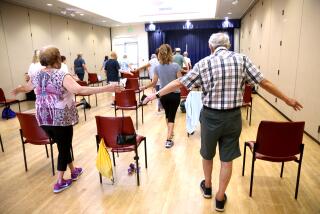Magazine for Older Readers Looking Robust : Media: Modern Maturity, edited in Lakewood, has become the nation’s largest circulation periodical by catering to the aging U.S. population.
- Share via
When a pharmaceutical company recently tried to place an advertisement with America’s largest circulation magazine--one showing a sweet young thing who turns into a haggard, hunched-back old woman because she forgets to take her calcium tablets--it was turned down flat.
“We don’t carry ads or editorials which show older people in negative, stereotyped categories,” explained the editor of Modern Maturity, J. Henry Fenwick.
His 34 million readers, all over age 50, and the magazine don’t want to be stereotyped as frail and the sick. “We want to show the positive side of getting older,” said Fenwick, “that people can still have active and successful lives well into retirement.”
Modern Maturity--owned by the American Assn. of Retired Persons, delivered as part of it $5 annual membership fee and edited outside the publishing mainstream in Lakewood--is itself a success story.
At a time when the consumer magazine industry is sick as a dog--ad revenues industrywide have plummeted nearly 5% so far this year--the bimonthly publication is still able to turn down 35% of the ads it is offered. And in keeping with its positive line on aging, Modern Maturity won’t publish ads for incontinence pads, anti-wrinkle creams, wheelchairs, hemorrhoid treatments or tub lifts.
Eight years ago, a typical issue of Modern Maturity would have included stories about how pets could help fight loneliness and letters from readers wondering about loose dentures or leaving their bodies to science. The ads typically were for such items as hernia belts and back braces.
The formula worked well. Modern Maturity had the fourth-largest circulation (8.3 million) of all American magazines, trailing only Reader’s Digest, TV Guide and National Geographic. Then an overwhelming majority of AARP’s members were comfortably in their 60s and 70s.
But these days, articles are an upbeat mix of self-help, travel pieces, tips on keeping the body and mind buzzing, consumer alerts, finance and even information on the number of elderly people with AIDS--about 10,000 over age 60, according to a National Institute on Aging study cited by the magazine.
Fenwick, who previously worked at Playboy and the BBC in London, has during the past year been responsible for steering the magazine toward a less pedantic, more upbeat and contemporary feel to suit AARP’s growing membership--an estimated 8,000 new members a day.
Now that many of his new readers are identifying with such quinquagenarians as Bob Dylan, and Joan Collins, he recognizes the need to appeal to the younger at heart.
“Our challenge is dealing with the increasing diversity of our readership, trying to excite someone who is 50 and working, while making the magazine interesting for someone in their 70s or 90s,” Fenwick said. “That’s three generations of people with different tastes and life experiences.”
Indeed, today it is almost impossible to tell by looking at the magazine’s content that Modern Maturity is aimed at an older audience. The current issue includes a special three-part report on how to stop burnout--at the office and in marriage--as well as features on insurance and motoring.
The main things that immediately set it apart from other general interest magazines is the slightly larger type and the predominance of middle-aged models in the photographs. Though it has relaxed its rigid ad policy--which used to exclude certain incontinence products, laxatives, dentures and other health items--these are still restricted to only 20% of the ad copy in each issue.
“They must also only show the positive after-effects of using the product,” says advertising standards director Treesa Drury, “not the negative symptoms.”
Modern Maturity began publishing in 1958 when a retired Los Angeles high school principal, Ethel Percy Andrus, founder of the National Retired Teachers Assn., expanded her efforts and formed the AARP.
About half of members’ dues are earmarked for the magazine. Members also receive discounts on prescriptions, insurance, travel and other benefits. And the association acts as a powerful--and increasingly controversial--lobby in Washington for older Americans.
The aging of America is proving to be a bonanza for the magazine. Although it only started taking ads in 1980--then because of financial difficulties--the circulation base rate for advertisers has zoomed from 5.3 million then to a formidable 22.4 million in 1991.
Figures for the first half of the year show advertising revenue of $23.1 million, down just 8% from the same period last year. It is a position many general interest publications might envy.
At about $250,000 a page for the full national run, advertising in Modern Maturity is not cheap, though companies can narrow ad buys to one-fourth the total circulation, one-half, or even a single state.
Advertising director Leda Sanford argues that the magazine offers a good value. “When you consider that we have 34 million members and you are reaching such a strong market at under $10 a person, it’s very efficient and well worth it,” she says.
Most analysts agree that the senior consumer market is becoming an increasingly powerful one.
At least 43 million Americans are over age 50, representing about one-third of the population, and the figure is expected to reach 113 million by the year 2025. They form a very powerful group, controlling about 50% of the country’s discretionary income (about $130 billion) and more than 77% of the personal assets.
Modern Maturity’s nearest rival for this market--New Choices for the Best Years--has a circulation of 580,392 and charges a $15.97 annual subscription fee.
Previously called 50 Plus, the magazine was bought by Reader’s Digest about two years ago and transformed into a glossy that focuses--according to a promotional blurb--on “the active adult whose home, rather than their workplace, becomes the center of their lives.”
Publisher Richard M. Fontana Jr. says New Choices, published in New York, is geared to a more upscale readership. “Our readers have a median income of about $46,000, compared with the $26,000 of Modern Maturity,” Fontana said. “They also have an older readership, whereas we cater to the active 55-65 age who are great consumers of luxury goods and services.”
Both magazines are gearing up for the baby boomers, who are set to begin hitting the 50 mark in five years. Each is pushing itself as a lifestyle publication aimed at the high-spenders among the aging.
“This is a very wealthy market which is growing every day, and there are few companies for whom the elderly are not an important part of their future,” explains Albert Traina, a New York magazine publishing consultant.
“Of all passages of life, old age and retirement is probably the only one on which we have not been schooled,” Traina says. “These types of publications have a role to play in informing and instructing people on how to best enjoy this period.”
America’s Top Magazines
Little read among the under 50s, Modern Maturity tops the Magazine Publishers of America’s top 10 chart for 1990.
Modern Maturity: 22,430,894
NRTA/AARP Bulletin: 22,103,887
Reader’s Digest: 16,264,547
TV Guide: 15,604,267
National Geographic: 10,189,703
Better Homes & Gardens: 8,007,222
Family Circle: 5,431,779
Good Housekeeping: 5,152,521
McCall’s: 5,020,127
Ladies Home Journal: 5,001,739
More to Read
Sign up for Essential California
The most important California stories and recommendations in your inbox every morning.
You may occasionally receive promotional content from the Los Angeles Times.













